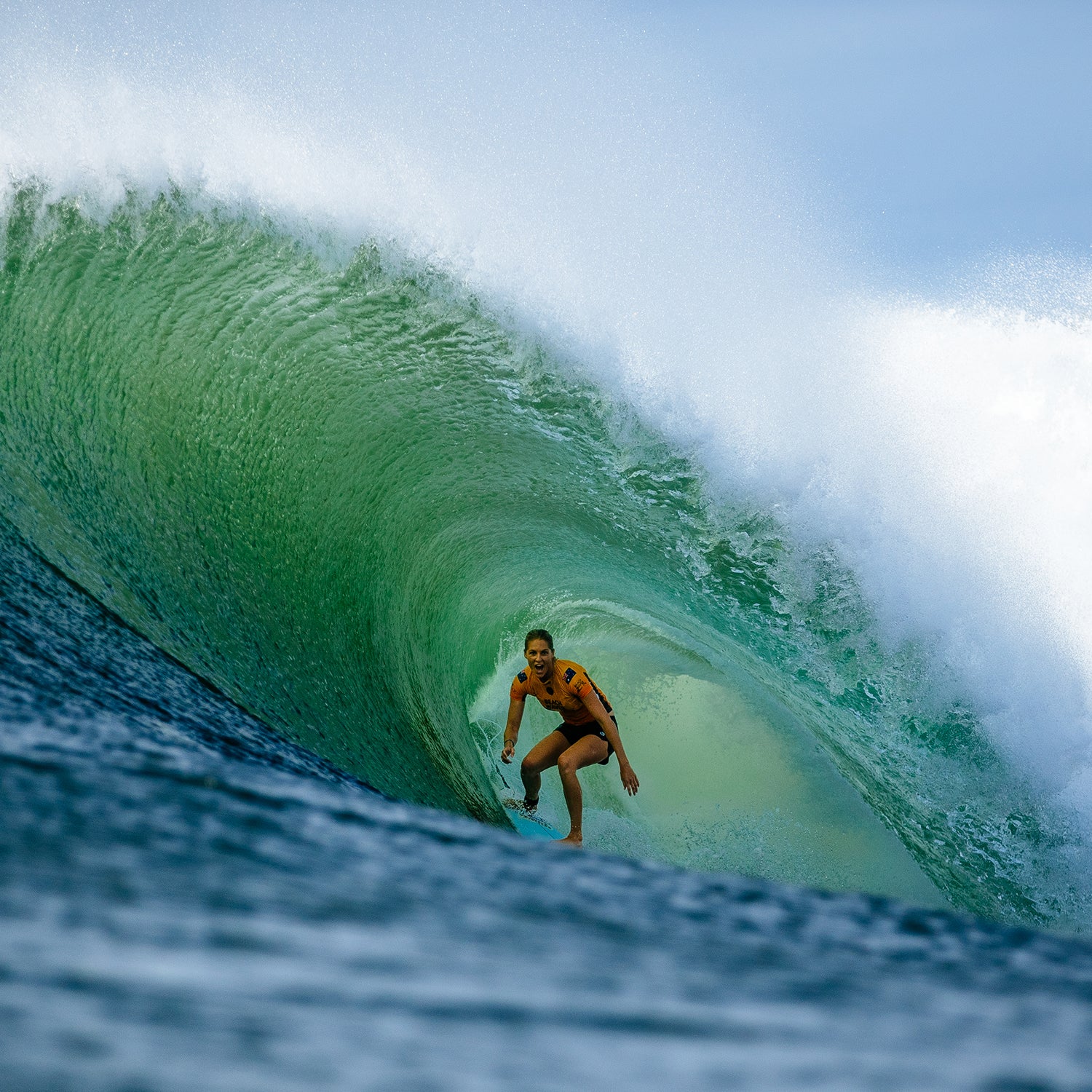Last week, the chatter among pro surfingÔÇÖs ranks centered on a massive swell steaming toward Maui, where the waves would converge with two of the most watched events of the World Surf LeagueÔÇÖs 2018 season. By Monday morning, at the infamous big-wave break┬áPeÔÇÖahi the ten women set to compete in the were staring down 50-foot mountains of raw, wind-shorn swell. Over the next few hours, the world witnessed Hawaiian Keala Kennelly lead the women through some of the biggest conditions ever seen in the sportÔÇÖs history, period. Meanwhile, 30 miles away at the Beachwaver Maui Pro, Australian was painting the idyllic blue walls of Honolua Bay with the smooth lines she is famous, and envied, for. By sunset, Gilmore had secured a record-tying seventh world title.
This year has been groundbreaking for womenÔÇÖs surfing. So it was only fitting that 2018 would culminate with Gilmore being crowned world champion. Gilmore, who is 30, now ties fellow Australian┬áLayne Beachley for the most ever womenÔÇÖs world title victories. By this past July, Gilmore had already foreshadowed greatness when she won her 29th tour event, more than any other woman. Surfers have a tendency to overuse the word legend┬áto the point of meaninglessness, but┬áwhen it comes to Gilmore, there is no better descriptor.
That the worldÔÇÖs best women surfers were dominating the airwaves on Monday no doubt deeply gratified the WSLÔÇÖs newÔÇöand first womanÔÇöCEO, Sophie Goldschmidt, who announced in September that┬ábeginning next year, the WSL will be giving equal prize money to its male and female athletes. Equal pay had been one of GoldschmidtÔÇÖs key mandates when she took over the WSL in 2017, along with getting surfing into the 2020 Olympic Games. To have Gilmore win the title was just the kind of you-canÔÇÖt-make-this-stuff-up artistry that Goldschmidt needed to cap off 2018.
For Gilmore, the crowning marked┬áanother rebirth in a career full of them.┬áShe began her pro career as a twiggy 19-year-old in 2007,┬áwhen she dominated formidable veterans, among them┬áBeachley and Kennelly, to win her first world title at Honolua Bay, which has long hosted the womenÔÇÖs tourÔÇÖs final stop of the season. No rookie in womenÔÇÖs pro surfing had ever accomplished such a feat. The perpetually sunny AustralianÔÇöbranded Happy Gilmore by┬áher then main sponsor Rip CurlÔÇöcontinued winning for the next three years. Her ascent marked a transition in womenÔÇÖs professional surfing, as Beachley, Kennelly, and other old-guard athletes retired and a new crop of young surfers (like Hawaiian Carissa Moore) entered the fray, more talented and competitive than their predecessors had ever been.
Suddenly, 23-year-old Gilmore was the tourÔÇÖs grizzled veteran. Personally, Gilmore saw herself similarly. This new, more serious mindset didnÔÇÖt jive with the youthful, airy one sheÔÇÖd been wedged into by Rip Curl. In 2010, she walked away from a lucrative re-signing offer to become the first woman ambassador and team rider for Quiksilver, which had always only sponsored its female athletes under its Roxy label. Gilmore embraced the confident, socially conscious, fashion-centered role that Quiksilver had tailor-made for her. The transition, however, coincided with a outside her home in Coolangatta, Australia, that left her with a broken wrist and lingering psychological trauma. At the end of 2011, Gilmore had slipped to third in the world tour rankingsÔÇöa disaster by her standards.
In a way, the attack and subsequent loss of the world title allowed Gilmore to take a step back and explore her form in the water. Where Beachley embraced her competitive ruthlessness and Moore her unrivaled power, Gilmore perfected a smooth, knock-kneed style that lent a grace to competitive surfing thatÔÇÖs rarely been seen on either the menÔÇÖs or womenÔÇÖs tours. She traveled around, rode retro boards, and played guitar with Jimmy Buffet. In between, she won two more world titles, in 2012 and 2014.
For the next three years, Gilmore bounced around the rankings. But when the 2018 season kicked off in Australia this past March, she settled into a scorched-earth campaign, winning three of the tourÔÇÖs ten events┬áand taking runner-up in two others. GilmoreÔÇÖs confident reemergence was only accentuated by Goldschmidt and her own ambitious mandate to bring the worldÔÇÖs best women and men surfers to the OlympicsÔÇöequally.
More than anything, GilmoreÔÇÖs seventh world title feels like the peopleÔÇÖs victory. Coupled with Kennelly and the women of the Jaws Challenge, itÔÇÖs a monumental win for progress┬áand for female athletes of every stripe. ItÔÇÖs also a clear sign that a record-breaking eighth title is on the horizon.


